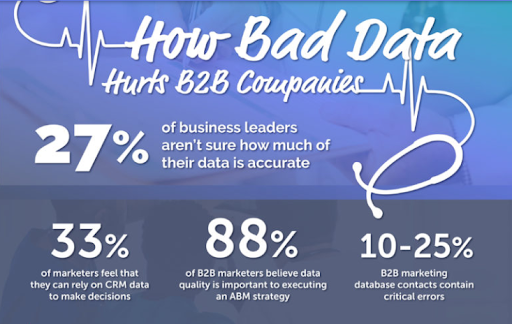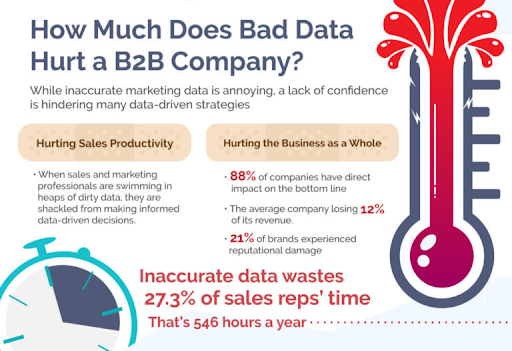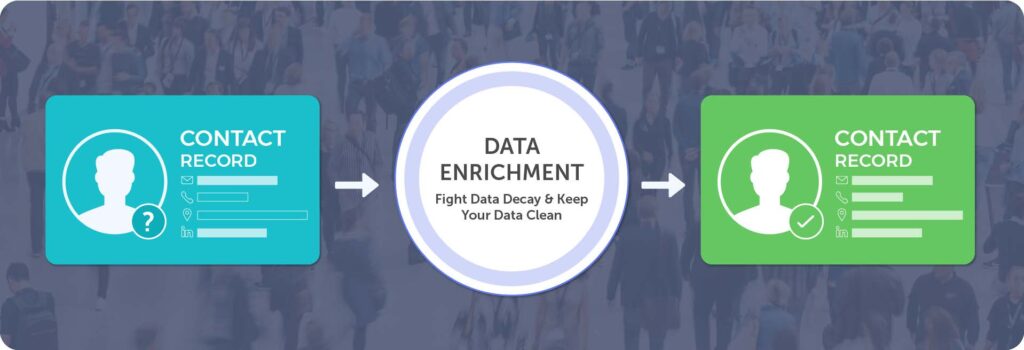You have spent long hours and a major investment putting in place a Customer Relationship Management (CRM) system to keep your database organized, maintain Data Quality, and your business development teams on track. 64.2% of firms believe CRM technologies positively influence their bottom line.
However, to boost sales, more than simply having a single location to handle contacts and accounts is required. Without high-quality data in your CRM, your sales and marketing teams will never fully grasp the value of your investment or their team’s potential.
Incomplete, incorrect, and out-of-date data are all examples of faulty data, and it’s a common issue. Management recognizes that implementing any data hygiene is a monumental effort, yet it is unavoidable. It might be time-consuming to cleanse your data, but data is the lifeblood of a CRM system, and erroneous data affects the entire system, sales effectiveness, and revenue.
We’re going to share how you can get the full benefits of your CRM without turning your sales team into data managers.
What Is Bad Data?
It’s difficult to pin down a specific definition of “Bad Data.” Some regard it as a purely technical phenomenon involving missing values, corrupted data, and incompatible file formats. Sure, those are all factors, but bad data is so much more.
Bad data is information that is incorrect, deceptive or lacks general formatting. It contains data that consumes your time and causes teams to lose trust in the CRM and each other. It’s data you can’t access, data you had but then lost, data that isn’t the same today as it was yesterday, and data you just can’t use for anything.
Regrettably, no industry, company, or department is immune. Bad data can cause major problems if it is not recognized and corrected early enough. However, few recognize the tremendous consequences of ignoring bad data, and even fewer take aggressive steps to battle and remedy the source or cause of bad data.
Is Data Quality Really Worth Worrying About?
Is incorrect data a major concern?
Yes.
However, before we get into how incorrect CRM data might affect your organization, let’s take a look at some statistics that highlight B2B companies’ perceptions of the data quality of their CRM data.

These figures can cause a slew of issues for companies. Bad data may have an impact on sales, marketing, customer service, retention, and practically every other area of your organization.
Bad data leads to revenue loss by interfering with your sales funnel. Bounced emails, wrong number phone calls, and being told your product doesn’t fit a prospect’s needs are all symptoms of bad data. Your organization may be pursuing prospects based on stale data, resulting in a significant potential cost in terms of obtaining additional business.

Here are some of the damages by inaccurate data:
- Poor data has a $9.7 million annual financial effect on enterprises.
- It is estimated that bad data costs the United States more than $3 trillion every year.
- Bad data causes sales productivity to squander approximately 27% of sales reps’ time.
What is Data Decay
The degradation and obsolescence of data to the point that it is no longer usable due to a loss of integrity, completeness, and accuracy is referred to as data decay.
Various factors might cause data to deteriorate. The inability to maintain accurate client information, such as sales, marketing, and CRM data, is the most common occurrence. If not effectively maintained, linkages and completeness of data sets may quickly become broken and out of date in systems that are always evolving and developing to meet business objectives. There is no one source of data in most businesses, but rather a collection of data sources spanning several platforms, formats, and views.
Another aspect that adds to data degradation is the human factor. Data is typically manually entered at some point along the journey. When erroneous or mistyped information is entered into a system, it can lead to data inconsistency, poor data hygiene, and degradation.
Guidelines to Improve Your CRM Data
You need to have a strong B2B database as the foundation for your engagement marketing/sales engine and your analytics engine to produce, monitor, and optimize ROI and revenue.
However, to get the most out of your CRM, you must follow basic rules to guarantee that the data is reliable, that you can get the proper insights from your data, and that you continue to optimize your data quality approach.
As a reliable B2B data partner, we urge that you follow the following five guidelines:
Accuracy
Is your information correct?
It needs to be. Otherwise, you have no reason to believe in your segmentation or your outreach. And untrustworthy data creates a vicious circle. The fewer representatives trust the data, the less they will rely on it, and the less they will care about updating and maintaining it, making the data even less reliable and continuing the cycle.
To ensure that your information is valid, it is critical to design procedures for reviewing, inputting, and updating CRM data from the beginning. Data hygiene is dependent on organizational culture since data is never completely correct and is always deteriorating.
Completeness
Do you have all of the information you need for each of your records?
Incomplete data is typical, particularly during the early phases of prospecting. However, continuously lacking essential data might be a huge issue, especially when analyzing your marketing and sales funnels.
You must decide what information is important to which functions and create procedures to obtain the information your team requires to accomplish their jobs efficiently.
Consistency
Is the data in your CRM system consistent?
For example, are all of your email addresses and phone numbers consistent? Is there a clear grading scale for consumers and opportunities presented? Is your information put in the correct fields?
When data is aggregated from numerous sources, data inconsistency becomes an issue. Data discrepancies can lead to erroneous and untrustworthy datasets. Data consistency ensures no mismatched data in fields, allowing your team to manage and utilize the information in your CRM efficiently.
Uniqueness
Is your CRM cluttered with redundant information?
Finding the information that users want may be extremely difficult if you do not have processes in place to combine and eliminate duplicate data entries, or, better yet, to prevent them from being created in the first place. Worse, it can disrupt automation by synchronizing or combining information from incorrect records or sending out redundant communications.
At the same time, removing duplicates at random might result in missing data since the information you want may be divided over numerous duplicate entries.
Timeliness
Is your data up to date?
Typically, timely data refers to ensuring that the information in your CRM is always actionable. After all, if the data you’re collecting isn’t assisting you in taking action, what’s the point of recording it?
Organizing and cleansing your CRM data regularly is an important approach for keeping it dependable, relevant, and up-to-date.
Data is often raw at the initial stage. When this collected data flows into a central database, it is ingested into the system in discrete datasets. What you often have when this happens is data being dumped into a data lake, or more accurately a data swamp, full of raw information that often isn’t useful outside of narrow contexts.
How to Fix Poor Data Quality Using Data Enrichment
Data has become the lifeblood of B2B businesses, powering marketing, sales, and support. Data quality is at the heart of every choice company executives make to encourage their organization’s growth and productivity.
Organizations must do the following to obtain reliable insights from corporate data and, eventually, boost sales:
- Have quick access to the information that is most important to them.
- Be certain that the data they are working with is accurate and up to date.
This is why data enrichment and cleaning are so important in today’s data-driven sales environment. In this section, we will explain what data enrichment is and why it is crucial for your sales force and business success.
What is Data Enrichment?

Data enrichment is the process of mixing raw data from your internal resources with data from other internal or external data sets to complete and correct the raw data. Data enrichment is a valuable commodity since it converts raw data into more accessible and insightful insights for any business.
Automating Data Enrichment with SalesIntel
Manual data enrichment needs human intervention and lengthens the sales interaction. Assume you decide to limit the form to three fields: name, email address, and phone number. If you want to get the remaining information throughout your chat, you may lose out on making your initial call beneficial.
SalesIntel’s automated data enrichment feature reduces the time required to acquire contact/company data at a later stage of the sales process. Furthermore, it enables marketers to keep sign-up forms as simple as possible, requiring only a name and an email address. The remainder of the data will be auto-populated in your CRM by the enrichment tool.
Automation of your data enrichment process with SalesIntel delivers various benefits to your organization in addition to reducing the tedious effort of gathering your leads’ data. Here are some of the areas where SalesIntel’s data enrichment automation may help you.
Advanced Segmentation
SalesIntel assists you in segmenting leads based on technographic and firmographic information. That implies you can utilize a laser-like focus to establish precise segmentation categories.
Increase Form Submission Rate
SalesIntel simplifies adding useful data points to your B2B database and prospecting lists. If you rely on inbound leads, simply request your prospect’s email address, and we’ll help you fill in the blanks. SalesIntel can incorporate human-verified data into your CRM automatically. This comprises firmographic information, technological information, and direct-dial phone numbers that you will need to carry out your sales and marketing strategies.
Removes Duplicate Entries
During the data enrichment process, SalesIntel verifies new information and replaces obsolete data. As a result, it does not generate a new entry, but rather updates the previous one with new and confirmed data.
Operates in Your CRM
SalesIntel allows you to execute a data enrichment activity in widely-used CRMs in addition to delivering contact and company data straight to the CRM.
Here’s an example of Salesforce enrichment.
How to Set Up and Use Data Enrichment from SalesIntel on Vimeo.
You can execute one-time enrichments or set up auto enrichment for accounts, leads, and contacts if you utilize Salesforce.
What’s Next?
SalesIntel has been supporting B2B organizations in closing their dream accounts and bolstering their account-based marketing efforts. We want your team to feel confident when contacting prospects and to spend time exclusively on quality leads by keeping all of your data clean, accurate, and enriched.
Gain access to millions of human-verified B2B contacts and maximize the value of your data with features such as buyer intent signals, data enrichment, technographic and firmographic filters, and more. If you wish to check the accuracy of our data, start a free trial.
Get the support system to help you improve efficiency across the revenue process, drive revenue predictability, and achieve revenue growth.





